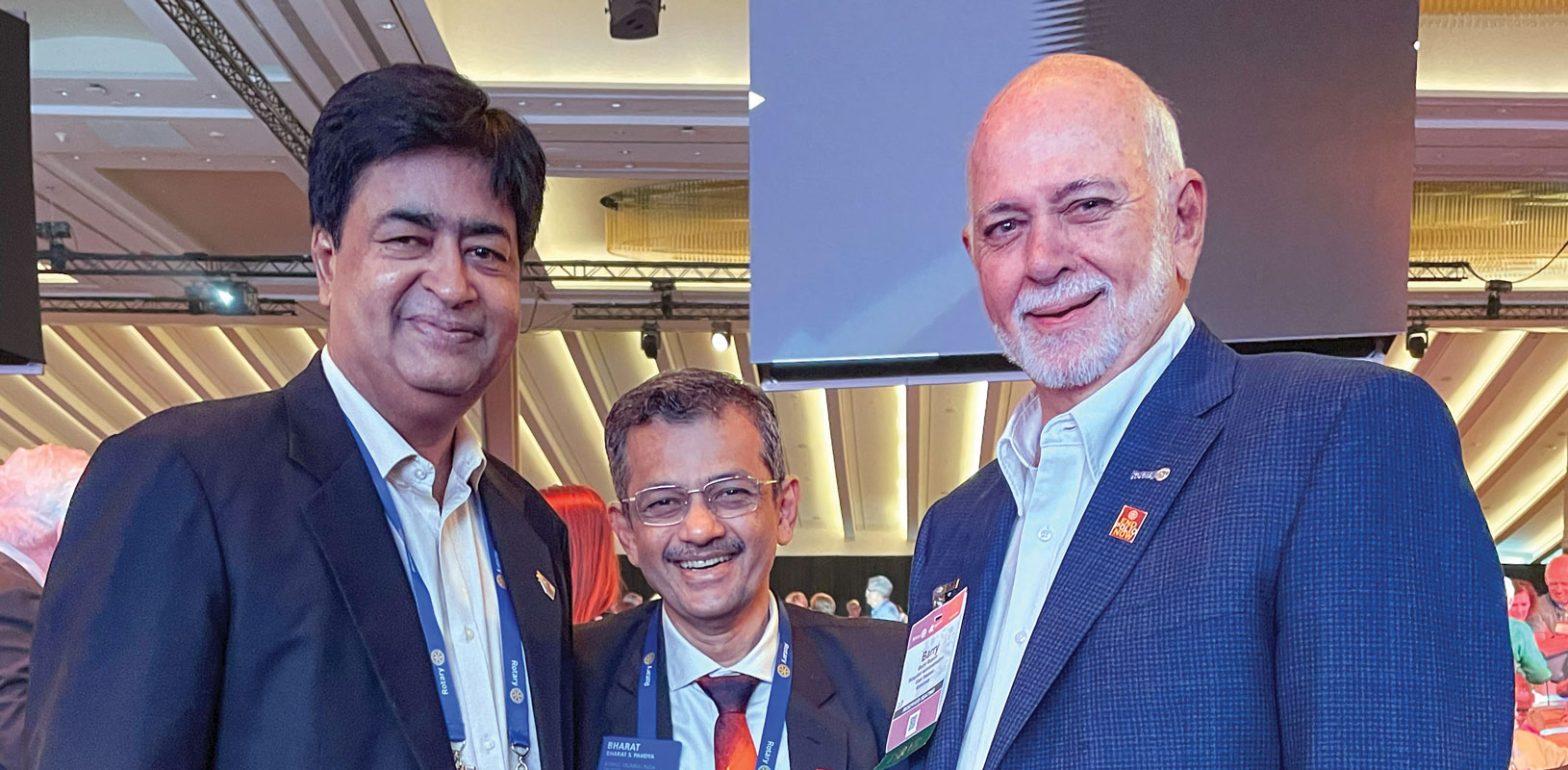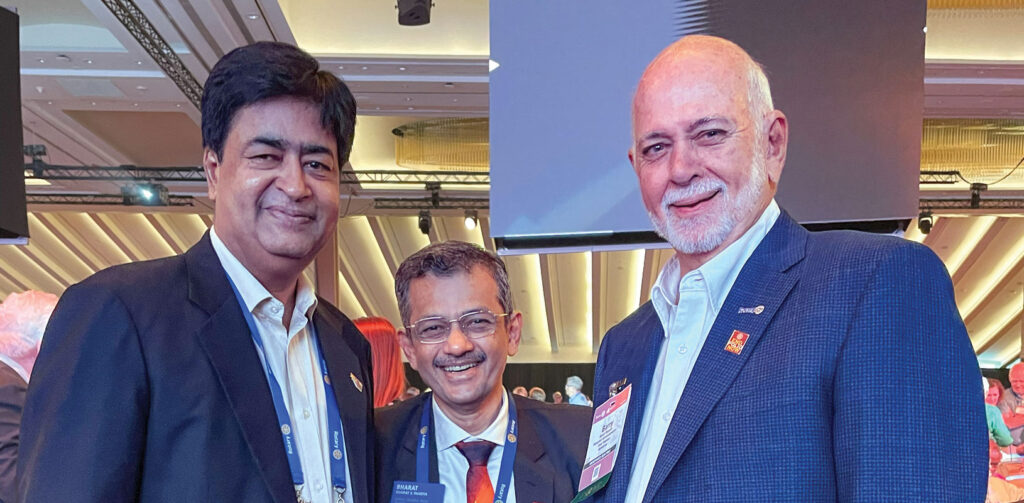
The Rotary Foundation chair Barry Rassin announced at the Singapore Convention that TRF had awarded 1,098 global grants during the 2022–23 Rotary year. “Just think about the scale of that work and the magnitude of our impact. Our work goes beyond global grants and supports every area of focus.”
Announcing the fourth Programs of Scale grant of $2 million for sustainable farming in India (See pg 20), Rassin said protecting the environment and supporting sustainable livelihoods remained Rotary’s priority. Restoration of mangroves in various regions of the world was being done with TRF grants. In the Philippines, Rotary clubs have participated in largescale plantings to protect and restore mangroves along shorelines as part of its Project Green environmental initiative. “Projects like this are underway across the globe, from the Bahamas to Kenya. And we will continue planting mangroves that protect sacred shores from erosion, build local economies, and capture immense amounts of carbon to help stave off the effects of climate change.”
That’s why it was important to meet TRF’s “ambitious fundraising goals. These are stretch goals, to be sure. But the more we do, the more we can help alleviate the impact of disease, poverty, and war. Big problems require big solutions. There’s no greater example of this than polio. Health workers in Pakistan and Afghanistan are putting their lives on the line every day, and they need our continued support.”
Rotarians could help these workers in many ways; by joining or initiating a PolioPlus Society in their clubs or districts and engage other members in this task at a historic moment when “we are so close to ending polio forever. And don’t forget that the Gates Foundation continues to amplify Rotary’s donations to polio eradication with a 2-to-1 match for every dollar,” he reiterated.
Ending polio remained Rotary’s primary aim; and towards this goal it was working to raise $2.025 billion by 2025 for TRF.
This year, TRF had set an ambitious fundraising goal of $500 million, and the “only way we will get there is with your support. I’m especially counting on Rotary and Rotaract members who have not yet contributed to make your first gift, as it will make a difference.”
Including Rotaractors
Bassin also urged Rotarians and Rotaractors to seek out global grant projects where they could make a difference. “Consider planning your biggest million-dollar dinner fundraiser or End Polio Now event. There are all sorts of ways to support our Foundation, but I encourage you to start small and dream big.” He also made a case for including Rotaract activities and projects in district grants, adding that now Rotaractors were also eligible for global grants.
One exciting global grant was presently funding a Rotaractor’s graduate study researching ways to use artificial intelligence to design and develop new, innovative drugs at a leading research centre in Germany. “Projects like this research grant have so much potential, if we dream big. And TRF has a history of supporting big dreams.”
Health workers in Pakistan and Afghanistan are putting their lives on the line every day, and they need our continued support.
— Barry Rassin, TRF Trustee Chair
The TRF chair recalled that it was at the Singapore Convention 25 years ago that Rotary had announced plans for its first peace centre. Now, 25 years later, thanks to a very generous donation of $15.5 million from the Otto and Fran Walter Foundation, Rotary was setting up its new peace centre at the Bahçeşehir University in Istanbul, Turkey. That opening was being celebrated with a presidential peace conference in Istanbul next year.
Striking a sombre note, Rassin said that Rotary’s systematic approach to peacebuilding is needed today more than ever. “We see proof of that all around the world today. For me, the conflict in Haiti has been particularly heartbreaking. Half of Haiti’s people are deprived of the fundamental right to clean drinking water. But amid the violence and chaos, Rotary members are working to improve the lives of Haitians.”
This they were doing through a programme called Hanwash, which has already brought drinking water to thousands of people. Rotarians were also partnering with local officials to improve the delivery of public services so Haitian communities could themselves sustain their clean water sources.
UN partnership in environment
Rassin disclosed that Rotary had now struck a strategic partnership with the United Nations Environment Programme. “This will give us a greater ability to protect, restore, and sustain freshwater ecosystems in our communities.” It was called the Community Action for Fresh Water Initiative, and he urged Rotarians to get involved in it and use it to plan projects, leverage Rotary grants and advocate for fresh water in their communities.
Giving a report card on the Programs of Scale grant for a Malaria-Free Zambia, the TRF chair said there was enough evidence to prove its benefits. The Zambia programme had not only increased Rotary’s visibility in that country, sparking the creation of three new clubs, it had also inspired a similar programme to address malaria in Uganda.
Another crucial area TRF was focusing was “nimbly addressing short-term priorities in communities during times of natural disasters. Over the past five years, TRF has awarded 274 disaster response grants amounting to $8 million, enabling our members to meet the urgent, time-sensitive needs of communities impacted by natural disasters.” But this grant too required Rotarians’ generous support, he added.
The money raised by Rotarians for TRF not only supported efforts to eradicate polio, but also resulted in global grants that impacted people around the world. “A few months ago, I witnessed a great example of this when I visited a hospital in India where doctors have performed over 4,200 paediatric heart surgeries thanks to a number of Rotary global grants.
And I will never forget the fire department and hospital in Taiwan where ambulances, critical care equipment, and paramedic training funded by Rotary have doubled the survival rate for heart patients.”
Rassin added that it was hard to describe what “it’s like to shake the hands of these doctors — to look into the eyes of children whose lives we have helped make whole again.” At the end of the day, such work was changing lives and creating hope across the world, he said.







